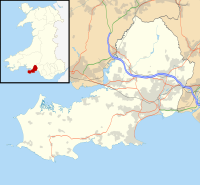
Swansea is a coastal city and the second-largest city of Wales. It forms a principal area, officially known as the City and County of Swansea.

Salisbury Cathedral, formally the Cathedral Church of the Blessed Virgin Mary, is an Anglican cathedral in the city of Salisbury, England. The cathedral is considered one of the leading examples of Early English Gothic architecture. Built over a relatively short period, some 38 years between 1220 and 1258, it has a unity and coherence of design that is unusual in medieval English cathedrals. The tower and spire were completed by 1330 and at 404 feet (123 m) is the tallest church spire in England.
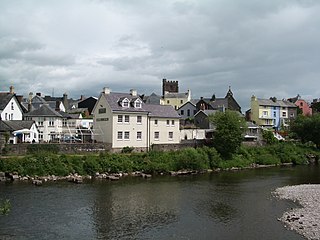
Brecon, archaically known as Brecknock, is a market town in Powys, mid Wales. In 1841, it had a population of 5,701. The population in 2001 was 7,901, increasing to 8,250 at the 2011 census. Historically it was the county town of Brecknockshire (Breconshire); although its role as such was eclipsed with the formation of the County of Powys, it remains an important local centre. Brecon is the third-largest town in Powys, after Newtown and Ystradgynlais. It lies north of the Brecon Beacons mountain range, but is just within the Brecon Beacons National Park.
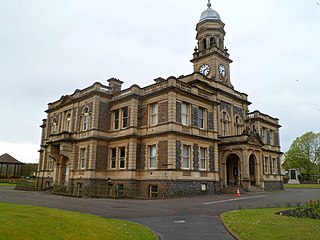
Llanelli is a market town and community in Carmarthenshire and the preserved county of Dyfed, Wales. It is located on the Loughor estuary and is also the largest town in the county of Carmarthenshire.
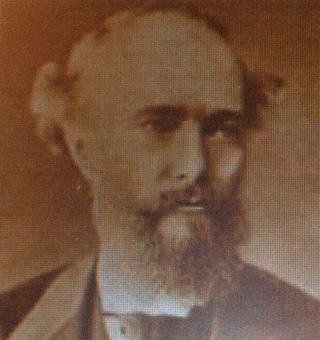
William Wilkinson Wardell (1823–1899) was a civil engineer and architect, notable not only for his work in Australia, the country to which he emigrated in 1858, but for a successful career as a surveyor and ecclesiastical architect in England and Scotland before his departure.

Bassaleg is a village on the west side of Newport, Wales. It is in the Graig electoral ward and community.

St Padarn's Institute came into being in 2016. Until then the site belonged to St Michael's College, an Anglican theological college in Llandaff, Wales. St Michael's college was founded in Aberdare in 1892, and was situated in Llandaff from 1907 until 2016. Among its many alumni was the poet R. S. Thomas. The original building on the site was a house constructed for himself by John Prichard. After his death, that building was incorporated into the newly founded St Michael's College, which was built mainly to the designs of F. R. Kempson between 1905 and 1907. In the late 1950s, a chapel was built by George Pace. The college had significant financial problems in the early 21st century and was eventually closed.
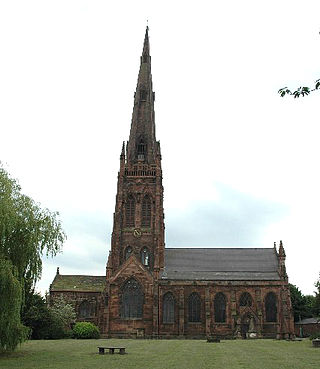
St Elphin's Church is the parish church of the town of Warrington, Cheshire, England. The church is recorded in the National Heritage List for England as a designated Grade II* listed building. It is an active Anglican parish church in the diocese of Liverpool, the archdeaconry of Warrington and the deanery of Warrington.
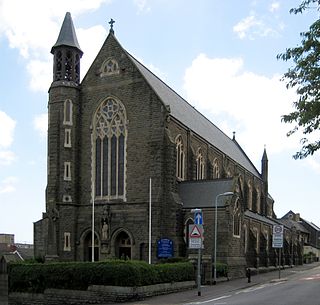
The Cathedral Church of Saint Joseph, also known as St Joseph's Cathedral, Menevia Cathedral or Swansea Cathedral, is a Grade II-listed Catholic cathedral in Swansea, Wales. It is the seat of the Bishop of Menevia and mother church of the Diocese of Menevia. The cathedral was built in the late nineteenth century and is located in the Greenhill area of Swansea.

Pennard is a village and community on the south of the Gower Peninsula, about 7 miles south-west of Swansea city centre. It falls within the Pennard electoral ward of Swansea. The Pennard community includes the larger settlements of Southgate and Kittle. the population as of 2011 was 2,688.

The University of Wales Trinity Saint David is a multi-campus university with three main campuses in South West Wales, in Carmarthen, Lampeter and Swansea, a fourth campus in London, England, and learning centres in Cardiff, Wales, and Birmingham, England.

St Thomas' Church is in Marton Street, Lancaster, Lancashire, England. It is an active Anglican parish church in the deanery of Lancaster, the archdeaconry of Lancaster and the diocese of Blackburn. The church is recorded in the National Heritage List for England as a designated Grade II listed building.

St Peter's Church is in High Street in the village of Mawdesley, Lancashire, England. It is an active Anglican parish church in the deanery of Chorley, the archdeaconry of Blackburn, and the diocese of Blackburn. The church is recorded in the National Heritage List for England as a designated Grade II listed building.

Holy Trinity Platt Church, is in Platt Fields Park in Rusholme, Manchester, England. It is an active Anglican parish church in the deanery of Hulme, the archdeaconry of Manchester, and the diocese of Manchester. The church is recorded in the National Heritage List for England as a designated Grade II* listed building. It is the second "pot church" designed by Edmund Sharpe, so-called because the main building material used in the construction of the church is terracotta.

St Peter's Church is a redundant Anglican parish church in St Peter's Square, Preston, Lancashire, England. It is recorded in the National Heritage List for England as a designated Grade II* listed building. It was a Commissioners' church, having received a grant towards its construction from the Church Building Commission. In 1973 it became part of Preston Polytechnic, later the University of Central Lancashire.

St George's Church is in St George's Street, Chorley, Lancashire, England. It is an active Anglican parish church in the deanery of Chorley, the archdeaconry of Blackburn, and the diocese of Blackburn. The church is recorded in the National Heritage List for England as a designated Grade II* listed building. It was a Commissioners' church, having received a grant towards its construction from the Church Building Commission.

St Mary's Priory Church, in Whitecross Street, Monmouth, Monmouthshire, Wales, is an Anglican church founded as a Benedictine priory in 1075. The current church dates mostly from the 18th and 19th centuries. It was designated a Grade II* listed building in 1952. It is one of 24 buildings on the Monmouth Heritage Trail.

Tythegston is a conservation area village located close to Cardiff and Swansea on the south coast of Bridgend, Wales. It is home to Tythegston Court, a Grade II listed manor house at the centre of the 1,200 acre Tythegston Estate which is designated at Grade II on the Cadw/ICOMOS Register of Parks and Gardens of Special Historic Interest in Wales. The estate has been owned by the Knight family for some 350 years and operates as a farming and property enterprise, with an industrial estate, as well as hosting green energy and food production. The seaside town of Porthcawl, with its numerous beaches is within 3 miles, as is Bridgend inter-city rail station. The village covers an area of 2,871 acres (1,162 ha). It is part of the community of Merthyr Mawr.

Mount Stuart Square is a residential and commercial square in Cardiff, Wales. It is located in the Butetown area of the city. Originally developed in the late 1800s as a residential location for nearby dock workers, it quickly became a centre for upscale residential properties which revolved around the main square. By 1900, commercial activity had taken its place, dominated by the Coal Exchange, which occupied the once open central space. The square contains a high concentration of listed buildings, which represent a range of architectural styles and some of Cardiff's finest examples of late 19th and early 20th century commercial architecture. Mount Stuart Square area was designated a Conservation Area in July 1980.

The Church of St Elli, Llanelly, Monmouthshire, Wales, is a parish church with its origins in the 14th century. The church underwent three major restorations, in 1867–1868, 1897 and 1910–1911. It remains an active parish church and is a Grade II* listed building. The church is dedicated to the 6th-century Saint Elli, who may have been a daughter or granddaughter of King Brychan, or a male disciple of Saint Cadoc.

